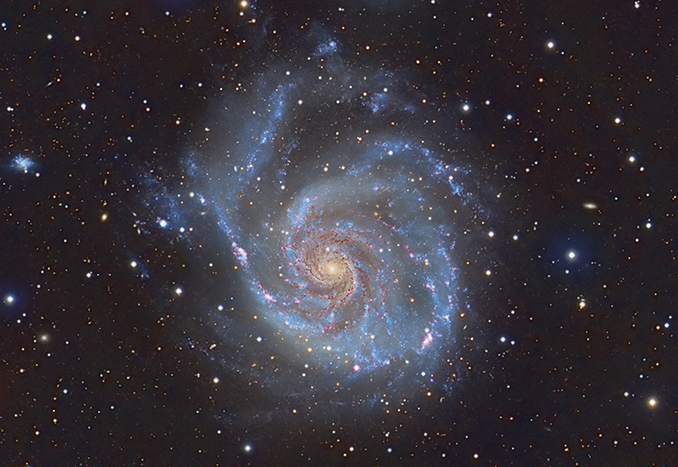The fact that Arp 93 appears to be a merger between a galaxy containing (not that much) gas and one completely devoid of it gives it certain characteristics. Let's first compare a collision between two galaxy completely lacking gas and dust with the gas-rich Antennae galaxies merger:
A "dry" merger between IC 1181 and IC 1178.
Credit: Detlef Hartmann.
As you can see, there are no dust lanes and no obvious clusters of any kind in the merger between IC 1181 and IC 1178. The bright clumps that seem to be located in the tidal tails of these galaxies are most likely background galaxies, although I have to admit that at least in the case of IC 1178, the bright clumps seem to outline a part of a ring around the galaxy's core and then dot the outline of its tidal tail. Nevertheless, the scarcity of gas and dust in these galaxies makes their merger a "dry" one.
In the case of the Antennae Galaxies, it is NGC 4038, at top in the image I posted, that is the truly gas-rich one. All the gas in NGC 4038 has led to a magnificent starburst in the disk of this galaxy. Actually I think that the most pink-bursting arc-shaped thing in NGC 4038 is actually a spiral arm that has been bent over backwards because of the tidal forces of the collision.
In Arp 93, there appears to be no star formation or even young stars at all in the disks of any of the two colliding galaxies. But gas has been driven out of NGC 7285 into a fantastically long and wide tidal feature, which does indeed contain some young blue stars. But the bluest part of NGC 7285 is one of its spiral arms.
Let's compare the overall appearance of Arp 93 with the overall appearance of the Antennae Galaxies, tails and all:
Arp 93: A Cosmic Embrace
Image Credit & Copyright: Mike Selby
It would seem that a lot more gas has been driven out of NGC 7285 than has been driven out of the Antennae Galaxies. The "My Favorite Martian" galaxies display two long and narrow tails, whereas NGC 7285 looks like it is emptying a bucket of liquids into space. Or, almost at least, as if someone is throwing boiling hot water into way-below freezing temperature air:
Edit: Come to thin of it, boiling water being thrown into far-below freezing temperatures and instantly turning into a cloud of ice crystals is not a good comparison with what is happening in the tidal tail of NGC 7285, because liquid water turning to ice is a "phase change", I think it's called, whereas the gas in NGC 7285 is merely being "thrown out". So the bucket simile it is. But I'm keeping the other picture too because it looks cool!

Edit 2: Come to think of it 2, IC 1181 and IC 1178 in the first picture I posted here are emptying buckets, too. Buckets of stars.
Buckets of stars like grains of sand.
Ann
 Arp 93: A Cosmic Embrace
Arp 93: A Cosmic Embrace





